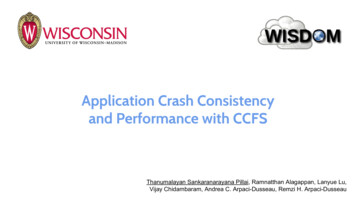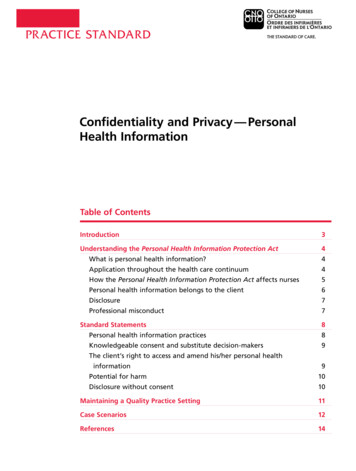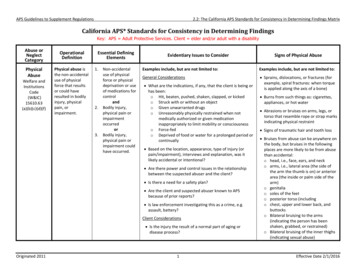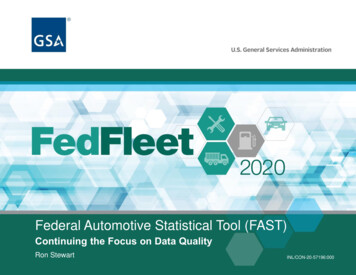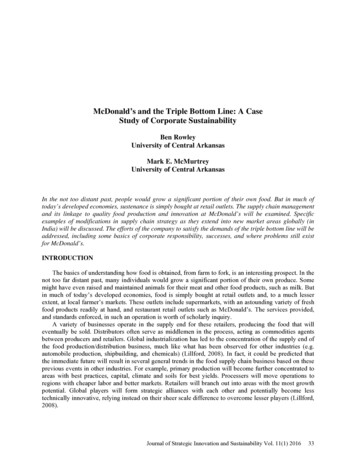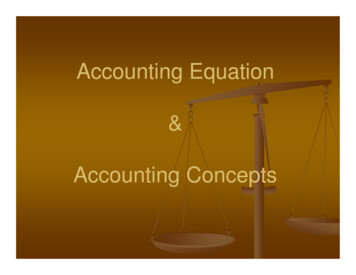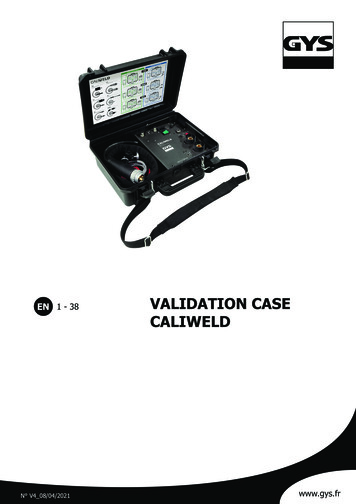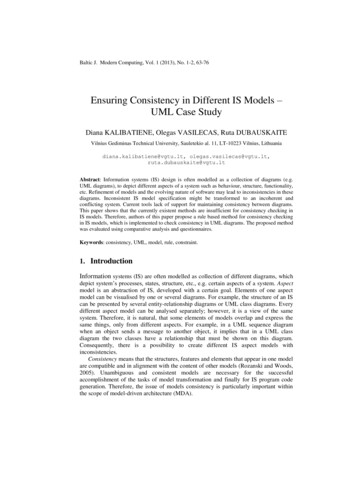
Transcription
Baltic J. Modern Computing, Vol. 1 (2013), No. 1-2, 63-76Ensuring Consistency in Different IS Models –UML Case StudyDiana KALIBATIENE, Olegas VASILECAS, Ruta DUBAUSKAITEVilnius Gediminas Technical University, Sauletekio al. 11, LT-10223 Vilnius, Lithuaniadiana.kalibatiene@vgtu.lt, bstract: Information systems (IS) design is often modelled as a collection of diagrams (e.g.UML diagrams), to depict different aspects of a system such as behaviour, structure, functionality,etc. Refinement of models and the evolving nature of software may lead to inconsistencies in thesediagrams. Inconsistent IS model specification might be transformed to an incoherent andconflicting system. Current tools lack of support for maintaining consistency between diagrams.This paper shows that the currently existent methods are insufficient for consistency checking inIS models. Therefore, authors of this paper propose a rule based method for consistency checkingin IS models, which is implemented to check consistency in UML diagrams. The proposed methodwas evaluated using comparative analysis and questionnaires.Keywords: consistency, UML, model, rule, constraint.1. IntroductionInformation systems (IS) are often modelled as collection of different diagrams, whichdepict system’s processes, states, structure, etc., e.g. certain aspects of a system. Aspectmodel is an abstraction of IS, developed with a certain goal. Elements of one aspectmodel can be visualised by one or several diagrams. For example, the structure of an IScan be presented by several entity-relationship diagrams or UML class diagrams. Everydifferent aspect model can be analysed separately; however, it is a view of the samesystem. Therefore, it is natural, that some elements of models overlap and express thesame things, only from different aspects. For example, in a UML sequence diagramwhen an object sends a message to another object, it implies that in a UML classdiagram the two classes have a relationship that must be shown on this diagram.Consequently, there is a possibility to create different IS aspect models withinconsistencies.Consistency means that the structures, features and elements that appear in one modelare compatible and in alignment with the content of other models (Rozanski and Woods,2005). Unambiguous and consistent models are necessary for the successfulaccomplishment of the tasks of model transformation and finally for IS program codegeneration. Therefore, the issue of models consistency is particularly important withinthe scope of model-driven architecture (MDA).
64Kalibatiene, Vasilecas and DubauskaiteThe problem of consistency checking of IS different aspects models arises whenseveral analysts and/or designers model the same system, since they can use differentterms for the same object of a domain. If the IS is large and complex, the risk ofconsistency conflicts in the models is bigger. Therefore, the issue of ensuringconsistency is even more relevant. Moreover, even one IS engineer often creates modelshaving consistency conflicts, because of (a) iterative process of IS development, (b) lackof knowledge and practice, etc.The problem of consistency checking of IS different aspects models in a designphase is important and it has been widely discussed in the publications of recent years.However, none of the analysed methods has been accepted as a standard yet.Ambiguous, not conforming to meta-model of modelling language, sometimesmeaningless consistency rules reduce the reusability and practical applicability of theproposed methods. Therefore, it is relevant to propose a method for consistencychecking of IS different aspects models using rules and paying special attention to therequirements for consistency rules.This paper is structured as follows. Section 2 presents related works on consistencychecking of IS models. Section 3 introduces the suggested method of ensuringconsistency in IS models. Section 4 presents the experiment performed to evaluate thesuggested method. Section 5 concludes the paper.2. Related worksAccording to Simmonds and Bastarrica (2005), consistency is a state in which two ormore elements, which overlap in different models of the same system, have asatisfactory joint description. The task is to ensure consistency of a model, consistencyof diagrams depends on accuracy of a model. A model can be visualised by severaldiagrams.Consistency can be classified to vertical (inter-model), horizontal (intra-model),evolution, semantic or syntactic. Vertical or inter-models consistency is checked atdifferent levels of abstraction between different aspects models (Lucas et al., 2009;Usman et al., 2008). Horizontal or intra-models consistency can be defined as amatching ratio between models at the same level of abstraction (ISO/IEC 1997).Evolution consistency is validated between different versions of the same aspect model(Straeten et al., 2003). All mentioned types of consistency can express syntactic orsemantic conformance of different aspects models. Syntactic consistency expressesmatching of models to the specifications of a meta-model. Semantic consistency requiresthat a model would be compatible to semantic meanings defined by a meta-model (Lucaset al., 2009; Usman et al., 2008). In this paper, we concentrate on improving modelssyntactic and semantic horizontal consistency of IS different aspects models expressedby a semi-formal language.Semi-formal models are widely used; therefore, they are of interest for us. For thedetailed study we choose semi-formal Unified Modelling Language (UML) (Matta et al,.2004; Cavarra et al., 2004; Cheng, 2001). Moreover, UML allows us to model differentaspects of IS. It is likely to be the most popular modelling language (Silingas andButleris, 2009). There are many modelling tools supporting UML (Shen et al., 2002).
Ensuring Consistency in Different IS Models – UML Case Study65UML was developed by Object Management Group 1 (OMG), which also introducedMDA (Lucas et al., 2009). Consistency of UML model is especially important in MDA,for automatic transformation of initial model to specific model and finally codegeneration tasks (Rozanski and Woods, 2005; Berkenkötter, 2008).Our research gives more attention to consistency of UML models. Therefore, therelated works that analyse conformance of different aspects models (expressed byconsistency rules) are selected for a more detailed analysis. As presented in (Ha andKang, 2008), there are several trends for consistency checking in UML diagrams: metamodel based methods (Paige et al., 2007), graph-based methods (Taentzer, 2004;Shuzhen and Shatz, 2006), scenario-based methods, constraint-based methods (are themost popular) and knowledge-based methods (like (Wang et al., 2012; Wang et al.,2006)). We are concentrated on meta-model and constraint based methods. The results ofanalysis are presented as follows.Table 1. Results of consistency rules analysisAuthor, Year [reference]Paige et.al., 2007Chanda et al., 2009Liu et al., 2002Rasch and Wehrheim, 2003Straeten et al., 2003;Straeten, 2004;Simmonds andBastarrica, 2005aShinkawa, 2006Kotulski, 2007Borba and Silva, 2010Ibrahim et al., 2011Total per diagram:Different rules:1http://www.omg.org/211131121111 12 4415 7 511035032 11152413111110 87 653321212114375322213831 formalruleExpressed ina formal language 12Associated OMG UMLmetamodel metaelementsare specified2Activity-Use caseActivity-StateSequence – Use caseSequence – ActivitySequence – StateClass–Use CaseExpressed in a naturallanguageSapna and Mohanty, 20071Total per source:Egyed, 2007Class–ActivityClass–StateConsistency rulesClass–SequenceAssociated different aspectsmodels1
66Kalibatiene, Vasilecas and DubauskaiteFor the detailed study 50 consistency rules were elicited from 11 related researches(see Table 1) and examined in order to:1. evaluate consistency rules, excluding redundant rules;2. find out whether the provided rules may be understood unambiguously;3. determine whether they conform to specification of a model – OMG UMLmetamodel;4. find out whether they are meaningful, i.e. whether they really show a conflict ofconsistency.The count of consistency rules associating UML models of specific aspects providedin the specific research is presented in Table 1, Part “Associated different aspectsmodels”. The line “Different rules” demonstrates how many various rules are presentedin different approaches among the same two aspects models.The three last columns in Table 1 indicate whether the rule expressed in a naturallanguage or/and a formal language and whether the associated metaelements from OMGUML metamodel (OMG, 2009; OMG, 2009a) are defined. A plus sign ( ) indicates thatall the rules provided in the paper have specific expression; otherwise, a number showsthe count of rules expressed in a natural language, containing metaelements from OMGUML specification or having a formal expression. The analysis shows that all theanalysed rules are expressed in a natural language, and most rules have a formalexpression. E.g., rules having formal expressions understood unambiguously. Moreover,according to the analysis these rules really show a conflict of consistency.Table 2 gives a summary of the analysed NoMagic MagicDraw, SybasePowerDesigner, Gentleware Poseidon for UML, IBM Rational System Architect andMicrosoft Visio tools.Table 2. Comparison of the design tools Magic Draw 17.0, Power Designer 16.1, Poseidon forUML 8.0, Rational Software Architect 11.3.1 and Visio 2010Compareddesign toolsComparisoncriteriaPowerMagicDesignerDraw 17.016.1Poseidonfor UML8.0RationalSoftwareArchitect11.3.1Visio20101. Model in conformity withmetamodel partially partially2. Correctness checking - -3. Consistency checkingpartially--partially-4. Language for expressing/implementation rules5. Technique of tools extensionwith new rulesOCL,JavaVisualBasicJavaVisualBasicVisualBasic (forMacros),.NET s,plug-in
Ensuring Consistency in Different IS Models – UML Case Study67The criteria for comparison are:1. Model in conformity with a metamodel. Possible values are “ ” (almostconform) and “partially” conform. If a model is in conformity with UMLmetamodel, it is checked according to one rule: name of a class has to be unique.If the tool does not allow creating a class with the same name in the model, thenit is assumed that the model almost conforms to the metamodel. It is said“almost” because it is not checked whether all constraints defined in ametamodel are implemented in the tool. If the tool allows creating two classeswith the same name, it is assumed that the model partially conforms to themetamodel. It is said “partially” because a tool does not implement all theconstraints defined in the specification of UML; however, it providesmetaelements defined in a metamodel.2. Correctness checking – constraints are defined at the metamodel level for oneaspect model, e.g. for a class diagram.3. Consistency checking – constraints are among 2 and more different aspectmodels at the metamodel level. Value “partially” means that there are onlyseveral rules that constrain two different aspect models, e.g. Class and Sequence.Meanwhile, other aspects models and their relationships (e.g. a class and states)are not included.4. Language for expressing/ implementation rules.5. Technique of tools extension with new rules. Examples are developing a moduleor plug-in, or macros or using other techniques for the extension of the tool withnew rules.Despite the existence of many tools, it is not easy to develop models that conform toUML metamodel. Moreover, not all available tools have a facility to check consistencyof IS models, and almost all defined constraints are for one aspect models.3. The Rule-Based Method for Consistency Checking in ISModels: UML Case StudyAccording to the results obtained during the analysis of the related works, 12 rules forconsistency checking is defined and the rule-based method for consistency checking inIS models is proposed. This method describes how to apply the defined rules. Although,Table 1 presents 32 rules, some of them overlap. Therefore, our 12 rules are inference ofTable 1. The defined rules are presented in (Dubauskaite and Vasilecas, 2013).An example of Rule 1 is as follows: The class which states are modelled has to beknown in the Protocol states model. The formal expression using OCL invariant for rule1 is provided below:context ProtocolStateMachine invprotocolStates without t notEmpty()The motivation of necessity of Rule 1 is as follows. A protocol state machinepresents possible and permitted transitions on the instances of its context classifier,together with the operations that carry the transitions (OMG 2009). Only classifier of a
M3: model of a model of a model(metametamodel)Four modelinglayers of OMG68Kalibatiene, Vasilecas and DubauskaiteStructure of detailed description of consistency rule its associations with metamodel ofmodelling language nestedPackageFragment of EMOF0.*NamedElement0.1Package nestingPackage owningPackage packagedElementPackagableElement0.* ownedType0.10.10.* packageTypedElement typeType typedElement0.*0.1StructuredFeatureClassifier memberEnd assosiation class ownedAttribute2.*PropertyClass0.10.10.*M2: model of a stance»«instance»{xor}{xor}Structure of detailed description of consistency ruleSimplified metamodel ofmodelling stency rule innatural language1uses2.*MetaElement1.*is detailed1.*Structured10.* consistency rulehas1 is formalizedPackage fordifferent aspect modelDescription1RuleFormal consistency1rule (e. g. OCL)1 is visualized byDiagramhas12.*MetamodelspecificlevelScope of nstance»1.*IS different aspect modelOrigin1«instance»M1: modelAssociation owedEnd owningAssociationis checked according toInstance ofconsistency rule0.*M0: system1.*1is expressed inInformation systemFig. 1. Structure of detailed description of consistency rule its associations with metamodel ofmodelling languageclass has operations; therefore, it can be derived that a protocol state machine is used tomodel states of classes. In this manner context – the class, which operations can becalled, and their execution that determines changes of states of the object, have to bedefined. The origin of this constraint is the analysis of UML superstructure specificationprovided by OMG (OMG 2009) and OOAD method. According to OOAD, significant
Ensuring Consistency in Different IS Models – UML Case Study69changes of the state of the object (described by the class) are modelled using statediagrams (Bennet et al. 2010).The scheme of the proposal is presented in Fig. 1. Description of consistency ruledoes not belong to metamodel level (it is not metamodel of instances of consistencyrules). But it associates elements of metamodel of modelling language (Fig. 1).The main ideas of the proposal are as follows:1. Check consistency of semi-formal IS models using consistency rules;2. Define consistency rules among different aspects IS models according to theserequirements:1.1. Define consistency rules at three abstraction levels: metamodel,independent, metamodel specific and formal/program code.1.2. Verify consistency rules according to a metamodel of modelling language.1.3. Motivate the necessity of rules defining its origin.1.4. Assign enforcement level to consistency rules according to their scope ofapplication.Fig. 2. Use case diagram of the proposed methodHaving achieved that the proposed method would better correspond to the existingOMG standards, it is defined using: Four modelling layers architecture (M0, M1, M2, M3), which OMG uses for itsstandards, like MDA. Essential MOF (EMOF), which is one of two compliance points (EMOF andCMOF (Complete MOF)) of MOF. MOF is an OMG standard (OMG, 2011) thatdefines the language to define a modelling language. A primary goal of EMOF is
70Kalibatiene, Vasilecas and Dubauskaiteto allow simple metamodels to be defined using simple concepts whilesupporting extensions for more sophisticated metamodelling using CMOF. The idea of modelling is based on three levels applied from OMG MDA standard(OMG, 2003).The usage of the method is presented in Fig. 2 by use case diagram.Below in Table 3 the main use case is described.Table 3. Use case “Apply the method for IS models consistency checking to the specific semiformal IS modelling language” descriptionUse case nameUnique IDActor(s)Brief descriptionPreconditionsMain flowAlternative flowsPost conditionsApply the method for IS models consistency checking to the specificsemi-formal IS modelling languageUC2Knowledge engineerKnowledge engineer creates a method for checking consistency of semiformal models (except UML models because they are included in aseparate use case UC1).There is a necessity to check consistency of specific semi-formal models.Knowledge engineer has enough knowledge about the specific language.The chosen specific language allows modelling a system from variousperspectives.Knowledge engineer knows any formal modelling language.1. Examine the method for IS models consistency checking.2. Collect data about new consistency rules using elicitationmethods.3. Specify rules at a metamodel-independent level.4. Define elements of a metamodel related by the rule.5. Specify a rule at the metamodel specific level.6. Express simpler rules in a formal language.7. Define the enforcement level of the rule.8. Explain the necessity, enforcement level (see the step above) ofthe rule).9. Repeat 3–8 steps for each rule.10. If it is necessary, modify the proposed process of IS modelschecking.If the selected semi-formal language is UML, then forward to task“Extend the method of UML consistency checking”.Consistency rules can be defined on class or/and attribute or/andassociation of metamodel.Enforcement level of the rule can be low, medium, high.The method for checking consistency of IS models expressed in a semiformal language is created.
Ensuring Consistency in Different IS Models – UML Case Study714. Application of the Proposed MethodThis section presents the experiment for checking understandability of the proposedmethod. Some parts of this experiment are published in scientific publications (Vasilecaset al., 2011; Dubauskaite and Vasilecas, 2010).In the experiment we demonstrate how various consistency rules from differentpapers (Egyed, 2007; Sapna and Mohanty, 2007; Chanda et al., 2009) and our rules(specified using the proposed requirements) are understood by analysts, designers,programmers, and quality engineers. The researches of Egyed (2007), Sapna andMohanty (2007) and Chanda et al. (2009) are selected for the experiment because theirapproaches are the most similar to our proposal compared to other analysed relatedresearches. The experiment is performed using questionnaires. The questionnaireconsists of 9 rules from the researches (Egyed, 2007; Sapna and Mohanty, 2007; Chandaet al., 2009) and our proposed rules without saying which rule is from which source, andquestions as presented in Table 4.Table 4. Questionnaire1.1 Do youunderstand semanticof the rule?YesMay beNo1.2 Do you knowwhat metaelementsare associated bythe rule?YesMay beNo1.3 Does the ruleconform to OMGUML metamodel?YesMay beNo1.4 Is the rule reliable(known origin) andnecessary (descriptionof application)?YesMay beNoIn this study the questionnaire is filled in by 14 specialists that have theoreticalor/and practical knowledge about UML. The participants are from various companies.Table 5. Application of the paired t-testInputH0H1CalculationsConclusionsThe 14 paired samples obtained having calculated a total number of answers‘yes’ (to the questions about unambiguity and reliability of consistency rulesfrom two methods), provided by 14 participants. (13, 4), (10, 7), (14, 10), (12,9), (10, 8), (8, 9), (8, 10), (11, 9), (9, 7), (14, 8), (12, 7), (8, 6), (11, 9), and (12,5).H0: The proposed method has the same quality (unambiguity and reliability)as the previous method.H1: The proposed method has better quality (more answers ‘yes’ aboutunambiguity and reliability) compared with previous method.Based on the data it can be seen that n 14. The mean of differences isd 3,143 (Formulas are provided in (Wohlin et al. 2000)). It can beidentified that Sd 3,931 and t0 4,011.A number of degrees of freedom is f n -1 14 – 1 13. In Table A1 from(Wohlin et al., 2000) book, t0.025, 13 2.160. t0 4,011 2.160 t0.5, 13 thereforeH0 is rejected and H1 is accepted with 95% (100%-5%) confidence level.
72Kalibatiene, Vasilecas and DubauskaiteThe study is based on the initial hypothesis that the proposed method is not betterthan the previous methods of specifying consistency rules.The collected data were processed using t-test method (Table 5).Fig. 3 demonstrates that IS engineers with different qualification understand theproposed consistency rules better compared to the previous rules.1412108Proposed method6Previous method420AnalystDesignerProgrammerTesterFig. 3. Understanding of different methods by specialists with various qualifications – counting of“yes” answersAdditionally the comparison of our proposed method with the three most similarmethods of other researchers is provided in Table 6. As can be seen, our method fulfilmore requirements than other three methods.According to the results of evaluation of consistency rules specifications, theproposed method is better than the other method of specifying rules. It allowsunderstanding rules less ambiguously because their semantic is more understandable andthe associated metaelements are known. The rules are also more reliable because theirorigin is known and they conform to the metamodel.Table 6. Evaluation of the proposed and three similar methods according to specific featuresFeature/ComparisonCriteriaEgyed, 20071. Technique of checkingconsistency of IS modelsConsistencyrules hard codedto UMLAnalyzer toolUML2. Language forexpressing IS modelsMethodsSapna andChandaMohanty,et al.,20072009OCL, SQLContextfreegrammarUMLUMLOur methodOCL, java andother executablelanguageSemi-formalmodellinglanguage, UMLis included
Ensuring Consistency in Different IS Models – UML Case StudyFeature/ComparisonCriteriaImplementation ofconsistency rulesSpecification ofconsistency rules3. Is a process ofchecking consistencydefined?4. Arerequirements ofconsistency rulesdefined?5. Are examplesof UMLconsistency rulesprovided?6. Is a set ofconsistency rulesqualitative2?7. Is there a toolfor automatingprocess of ISmodelsconsistencychecking?8. Is anenforcementlevel of thedetectedviolation of aconsistency ruleprovided3?73PartiallyMethodsSapna andChandaMohanty,et sYesNoNoNoPartiallyYesNoNoYesNoNoNoYesEgyed, 2007Our methodComparison of total count answers ‘yes’ shows that the quality of the proposed rulesis by approximately 40,74% better than the quality of consistency rules specificationsprovided in previous researches (Egyed, 2007; Sapna and Mohanty, 2007; Chanda et al.,2009).5. ConclusionsAnalysis of consistency rules shows that most rules are expressed in natural and formallanguage. Rules expressed in natural language may be interpreted ambiguously. Formalrules usually use their own description of UML models. Therefore, it remains unclearwhat elements of an OMG UML metamodel they conform to. Moreover, some2Unambiguous, known origin and practical necessity, conformance to the metamodel of themodelling language.3It indicates the necessity of performing changes of models according to a consistency rule.
74Kalibatiene, Vasilecas and Dubauskaiteconsistency rules do not conform to an OMG UML metamodel, and their practicalnecessity is doubtful.The analysis of UML design tools demonstrates that most of them allow developingmodels that do not conform to the UML metamodel. It means that consistency rules haveto associate metaelements from different aspects of models despite the fact that they aredirectly associated in a metamodel.The rule-based method for consistency checking in IS models is created. It is freefrom modelling language and is applied to UML. The feasibility of the proposed methodis illustrated creating 12 consistency rules for UML models according to the proposedrequirements. The rules are defined at the metamodel level; therefore, they can beimplemented in any design tool that supports a UML 2.2 metamodel.The evaluation of the results obtained during the experiment showed that theproposed requirements for consistency rules improve the quality of a set of the rules (lessambiguity, more reliability) by approximately 41% in comparison with other similarmethods. The consistency rules that are specified according to the proposed requirementsare also more understandable by IS engineers compared with the rules provided by otherresearches.ReferencesBennet, S., McRobb, S., Farmer R. (2010). Object-Oriented Systems Analysis and Design UsingUML. 4th ed. London.Berkenkötter, K. (2008). Reliable UML Models and Profiles. ENTCS, 217, 203–220.Borba, C.F., Silva, A.E. (2010). Knowledge-Based System for the Maintenance Registration andConsistency among UML Diagrams. LNCS, 6404, 51–61.Cavarra, A., Riccobene, E., Scandurra, P. (2004). A framework to simulate UML models: movingfrom a semi-formal to a formal environment. In: Proc. of the 2004 ACM Symposium onApplied Computig (SAC’04), New York, pp. 1519–1523.Chanda, J., Kanjilal, A., Sengupta, S., Bhattacharya, S. (2009). Traceability of Requirements andConsistency Verification of UML UseCase, Activity and Class diagram: A FormalApproach. In: Proc. of International Conference on Methods and Models in ComputerScience 2009 (ICM2CS09), New Delhi, pp. 1–4.Cheng, H.C. (2001). A Metamodel-Based Approach to Formalizing UML. In: Proc. of the 25thAnnual International Computer Software and Applications Conference (COMPSAC'01),Wasshington.Dubauskaite, R., Vasilecas, O. (2010). The approach of ensuring consistency of UML model basedon rules. In: Proc. of the 11th International Conference on Computer Systems andTechnologies (CompSysTech'10), Sofia, ACM Press, 471, pp. 71–76.Dubauskaite, R., Vasilecas, O. (2013). Method on specifying consistency rules among differentaspect models, expressed in UML. Electronics and electrical engineering, 19(3), 77–81.Egyed, A. (2007). Fixing inconsistencies in UML design models. In: Proc. of the 29thInternational Conference on Software Engineering (ICSE 2007), New York, pp. 292–301.Ha, I., Kang, B. (2008). Cross checking rules to improve consistency between UML Staticdiagram and Dynamic Diagram. In: Fyfe, C et al. (Eds.): IDEAL 2008, LNCS, 5326, pp.436–443.Ibrahim, N., Ibrahim, R., Saringat, M.Z., Mansor, D., Herawan, T. (2011). Consistency Rulesbetween UML Use Case and Activity Diagrams Using Logical Approach. InternationalJournal of Software Engineering and Its Applications, 5(3), 119–134.ISO/IEC 1997. Information Technology – Software quality characteristics and metrics – Part 3:Internal Metrics. International Organization for Standardization and InternationalElectrotechnical Commission.
Ensuring Consistency in Different IS Models – UML Case Study75Kotulski, F.L. (2007). Assurance of system consistency during independent creation of UMLdiagrams. In: Proc. of the International Conference on Dependability of Computer Systems(DepCoS-RELCOMEX 2007), Szklarska Poreba, pp. 51–58.Liu ,W., Easterbrook, S.M., Mylopoulos, J. (2002). Rule-based detection of inconsistency in umlmodels. In: Proc. of the 5th International Conference on the Unified Modelling Language(UML’02), London, pp. 106–123.Lucas, F.J., Molina, F., Toval, A. (2009). A systematic review of UML model consistencymanagement. Information and Software Technology, 51, 1631–1645.Matta, A., Furia, C., Rossi, M. (2004). Semi-formal and formal models applied to flexiblemanufacturing systems. LNCS, 3280, 718–728.OMG (2003). MDA Guide Version 1.0.1, http://www.omg.org/cgi-bin/doc?omg/0306-01.OMG (2009). Unified Modelling Language (OMG UML), version /PDF.OMG (2009a). Common Variability Language OMG (2011). Meta Object Facility (MOF) Core ige, R.F., Brooke, Ph.J., Ostroff, J.S. (2007). Metamodel-based model conformance andmultiview consistency checking. Transactions on Software Engineering and Methodology,16(3), 11.Rasch, H., Wehrheim, H. (2003). Checking Consistency in UML Diagrams: Classes and StateMachines. Formal Methods for Open Object-Based Distributed Systems. LNCS, 2884, 229–243.Rozanski, N., Woods, E. (2005). Software System Architecture. London, 546 p.Sapna, P.G., Mohanty, H. (2007). Ensuring consistency in relational repository of UML models.In: Proc. of the 10th International Conference on Information Technology (ICIT 2007),Rourkela, pp. 217–222.Shen, W., Compton, K., Huggins, J.K. (2002). A Toolset for Supporting UML Static and DynamicModel Checking. In: Proc. of the 26th International Computer Software and ApplicationsConference, Prolonging Software Life: Development and Redevelopment (COMPSAC 2002),Oxford, pp. 147–152.Shinkawa, Y. (2006). Inter-Model Consistency in UML Based on CPN Formalism. In: Proc. of the8th Asia Pacific Software Engineering Conference (APSEC’06), Washington, pp. 411–418.Shuzhen, Y., Shatz, S.M. (2006). Consistency Checking of UML Dynamic Models Based on PetriNet Techniques. In: 15th International Conference on Computing (CIC '06), pp. 289–297.Silingas, D., Butleris, R. (2009). Towards Implementing a Framework Modelling SoftwareRequirements in MagicDraw UML. Information Technology and Control, 38(2), 153–164.Simmonds, J., Bastarrica, C.M. (2005). A
can be presented by several entity-relationship diagrams or UML class diagrams. Every different aspect model can be analysed separately; however, it is a view of the same system. Therefore, it is natural, that some elements of models overlap and express the same things, only from different aspects. For example, in a UML sequence diagram

